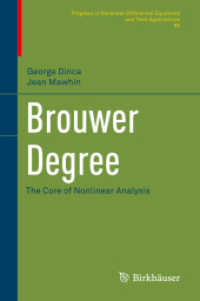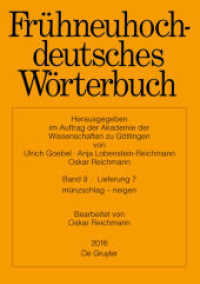- ホーム
- > 洋書
- > ドイツ書
- > Mathematics, Sciences & Technology
- > Technology
Full Description
The concept of virtual manufacturing has been developed in order to increase the industrial performances, being one of the most ef cient ways of reducing the m- ufacturing times and improving the quality of the products. Numerical simulation of metal forming processes, as a component of the virtual manufacturing process, has a very important contribution to the reduction of the lead time. The nite element method is currently the most widely used numerical procedure for s- ulating sheet metal forming processes. The accuracy of the simulation programs used in industry is in uenced by the constitutive models and the forming limit curves models incorporated in their structure. From the above discussion, we can distinguish a very strong connection between virtual manufacturing as a general concept, ?nite element method as a numerical analysis instrument and constitutive laws,aswellas forming limit curves as a speci city of the sheet metal forming processes. Consequently, the material modeling is strategic when models of reality have to be built. The book gives a synthetic presentation of the research performed in the eld of sheet metal forming simulation during more than 20 years by the members of three international teams: the Research Centre on Sheet Metal Forming—CERTETA (Technical University of Cluj-Napoca, Romania); AutoForm Company from Zürich, Switzerland and VOLVO automotive company from Sweden. The rst chapter presents an overview of different Finite Element (FE) formu- tions used for sheet metal forming simulation, now and in the past.
Contents
Fundamentals of metal plasticity.- Plastic behaviour of sheet metals.- Anisotropy of sheet metals.- Yield criteria-A review.- Recommendations on the choice of the yield criterion.- Formability of sheet metals.- Evaluation of the sheet metal formability.- Forming Limit Diagrams.- Theoretical prediction of the Forming Limit Curves.- Numerical simulation of the sheet metal forming processes.- FE models of the sheet metal forming processes.- Presentation of the AUTOFORM program.- Forming Limit Diagrams in the FE commercial programs.- Simulation of hydroforming processes.- Simulation of deep-drawing processes.- Simulation of the industrial parts.- Robust design of sheet metal forming processes.







